Editor’s note: In this volatile market, money moves faster than ever – but Tom Gentile’s discovery could give you the chance to become thousands of dollars richer – almost instantly. In this shocking LIVE footage, he’s sharing the secret that transformed him from a Home Depot clerk to a stock market multimillionaire. His record is $1,260 richer in eight seconds… but he’s confident you could beat it. Click here to learn how.
Dear Red Alert Reader,
Maybe you’re looking to fund a child’s education…
Or perhaps you want to quickly achieve a seven-figure retirement…
Both worthy goals.
Or maybe you just want to stack up enough to buy that Lexus you’ve long had your eye on.
That’s okay, too.
Whatever your goals are, I’m here to help you achieve them.
And part of every investor’s strategy should be a diverse portfolio.
That’s advice just about every so-called expert out there will give you – and they’re right.
But here’s something they won’t tell you.
Just about every investor should spread a small but crucial amount of their capital across a handful of highly speculative microcaps.
Now let’s get real here. We’re talking penny stocks.
Specifically stocks with market caps of $500 million or less and/or that cost under $5 per share.
Now “penny stock” is a dirty word in much of the investing world. But that’s because those naysayers are thinking of boiler-room scams in which salesmen use high-pressure tactics to get you to buy fraudulent stocks.
We’re not talking about that here.
We’re talking small, highly innovative technology and biotech startups that have chosen to go the publicly traded route rather than take the venture capital road.
Of course, tech microcaps – penny stocks – are riskier than large caps. And they’re more volatile.
But their upside potential is exponentially greater…
It Happens Every Single Day
And that’s why you should have a small part of your portfolio dedicated to them.
Shares of heavy hitters like Alphabet Inc. (NasdaqGS: GOOGL), Amazon.com Inc. (NasdaqGS: AMZN), and Netflix Inc. (NasdaqGS: NFLX) can cost hundreds of dollars per share. They simply can’t jump the two times, five times, or even the 10 times you’d need to become rich anytime soon, if at all.
But it’s easy for microcap stocks to jump from $1 to $2 to $20 or more.
In fact, it happens every single day.
Here’s just one example…
On Tuesday, Sept. 18, 2018, a little-known consumer goods company called New Age Beverage Corp. (NasdaqCM: NBEV) soared 103% on reports that The Coca-Cola Co. (NYSE: KO) is considering a takeover bid for the company.
New Age continued to rally for the rest of the week, closing on Friday at a price of $6.15 – a 286% gain over Monday's opening price.
That’s just one part of the appeal of microcaps – a space that’s consistently outperformed larger indices and larger stocks over the years, while allowing shareholders to acquire significant stakes in rapidly growing companies for pennies on the dollar.
While I’m glad you turned here for my research, I also want to give you information that you can use to forge your own path.
So in this report, I’ll show you my three rules for playing penny tech stocks so that the risk and volatility we’ve been talking about don’t take your shirt.
But you came here for company names and ticker symbols. So I’ll deliver some of those, too.
Have 28 Seconds? You could make $2,353 – and you won't need to buy a single share of stock up front to collect this cash. Click here to learn more…
Now after New Age's explosive run last week, there may be little upside left — so in this report, I’ve identified five more penny tech stocks with serious growth potential.
Let’s get started…
Penny Tech Stock No. 1
Why a Labor Shortage Could Make This Stock Pop
The U.S. unemployment rate fell to 3.7% in September 2018 — the lowest level since December 1969.
So not surprisingly we’re hearing that companies are finding it difficult to find enough employees to fill their payrolls.
And that means more robots will be needed than ever before.
The National Bureau of Economic Research reports that there are just 1.75 robots for every 1,000 workers, totaling about 255,146 robots in operation in the United States.
That number will hit 5.25 per 1,000 by 2025, which means the number of robots in service will grow by at least 765,000 in the next seven years.
Worldwide, the numbers are equally staggering. In fact, the International Federation of Robotics projects a 116% increase from the 1.2 million in service today to 2.6 million units by 2019.
What I like about this is that all three data sets are likely extremely conservative. I believe that the number is double or triple that when you include smart robotics, artificial intelligence, and other forms of machinery we don’t presently consider to be robots.
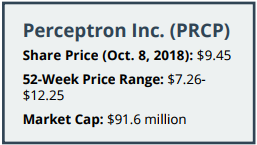 And that brings me to my first penny tech stock: Perceptron Inc. (NasdaqGM: PRCP).
And that brings me to my first penny tech stock: Perceptron Inc. (NasdaqGM: PRCP).
Founded in 1981, and based in Plymouth, Mich., the company supplies automated industrial metrology products and solutions to automotive, aerospace, and other manufacturing companies around the world.
Perceptron’s products include 3D machine vision solutions, robot guidance, coordinate measuring machines, laser scanning, and advanced analysis software – all of which are critical to the precision that comes along with automated manufacturing.
The company boasts more than 900 systems, 12,000 measuring sensors, and 3,000 COORD3 coordinate-measuring machines in active daily use worldwide.
On Aug. 29, 2018, Perceptron reported consolidated net sales of $23.6 million, its highest quarterly revenue ever and an increase of 5.8%, compared to the fourth fiscal quarter one year ago. Net income came in at $0.8 million, up significantly compared to net income of $0.2 million in the prior-year quarter.
For the quarter, the company reported bookings of $19.9 million, and backlog came in at $47.5 million, a record high.
The company’s balance sheet also looks great. It’s holding no debt and $6.7 million in cash. Those might sound like small numbers, and they are, but Perceptron is a small company with a recent market cap of $91.6 million.
Add those together – small market cap… the increasing adoption, as measured by record bookings and backlog… and a solid balance sheet – and I think Perceptron could make an attractive acquisition target for a robotics giant like Kawasaki Heavy Industries (with 110,000 installed robots worldwide), KUKA (with 80,000 installed robots worldwide), Mitsubishi Robotics (with 70,000 installed robots worldwide), or even FANUC.
Critical: Tom Gentile just shared an invention that helped him become $4,238 richer in just four moves. You need to see this to believe it.
Penny Tech Stock No. 2
Esports + Crypto Mining = Big Profits
Our second penny tech stock, United Microelectronics Corp. (NYSE: UMC), is a semiconductor company based in Hsinchu, Taiwan.
Founded as Taiwan's first semiconductor company in 1980, UMC is best known for manufacturing integrated circuits used by larger semiconductor companies like Nvidia Corp. (NasdaqGS: NVDA) in their products.
As a central supplier to major semiconductor manufacturers, UMC is perfectly positioned to profit from the semiconductor industry's global boom.
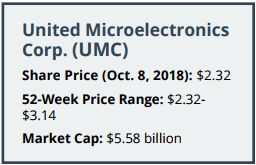 You see, semiconductor chips are an essential part of cryptocurrency mining and esports – two of the fastest-growing digital industries.
You see, semiconductor chips are an essential part of cryptocurrency mining and esports – two of the fastest-growing digital industries.
Esports are multiplayer video game competitions for professional gamers. Esports have bolstered the sale of the gaming consoles needed for the sport – consoles that require hundreds of thousands of semiconductor chips for production.
In 2018 alone, esports are expected to grow by 38% and break $1 billion in revenue by 2019.
Semiconductor chips are an essential part of crypto mining, too – they provide the processing power necessary for unlocking blockchain algorithms.
In 2017, global crypto mining increased 8,500%, helping to drive the semiconductor industry's 35% growth. Major semiconductor producer Advanced Micro Devices Inc. (NasdaqCM: AMD) announced that more than 10% of 2018's first-quarter revenue was the result of crypto-mining purchases.
Thanks to these strong tailwinds behind it, global semiconductor industry sales are expected to grow from $408 billion in 2017 to $439 billion in 2018 – a growth of 7%.
And UMC is cashing in on this boom.
This global production and distribution system has allowed UMC to aggressively grow its bottom line over the last three years.
Between 2015 and 2016, UMC's net income for continuing operations jumped over 60%
UMC stock was recently trading for $2.32 and has serious potential to keep rising as the semiconductor industry soars.
Penny Tech Stock No. 3
The Patent Manager
Next up is a holding company that manages the pharmaceutical patents generated by Facet Biotech, the company's research and development branch.
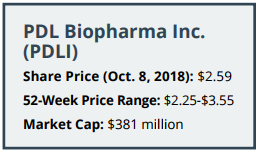 Since most of PDL Biopharma Inc. (NasdaqGS: PDLI)’s original patent holdings expired in 2016, the company has undergone an aggressive restructuring effort to streamline profitability.
Since most of PDL Biopharma Inc. (NasdaqGS: PDLI)’s original patent holdings expired in 2016, the company has undergone an aggressive restructuring effort to streamline profitability.
Shortly after several of PDL's holdings expired, the company established a majority ownership position in Noden Pharma DAC, a pharmaceutical company that owns the popular blood-pressure drug Tekturna.
This deal was PDL's first acquisition of a commercial asset that could directly generate income for the company – and it's been paying off.
In 2017, PDL grew its year-over-year revenue and beat earnings estimates for every quarter.
And PDL's current market valuation makes it an absolute bargain.
PDL has an incredibly low price-to-book ratio of 0.5. As a result, if the company's share price rose to equal its book value, it would double – giving investors a 100% return.
Plus, PDL has more cash on hand than the company's market cap indicates – making the company undervalued by default. At a recent $2.59 a share, that's an absolute steal.
As PDL continues to stage a dramatic turnaround, this discrepancy will quickly be corrected – and penny stock investors should lock in this profit opportunity now.
Penny Tech Stock No. 4
The Hidden Way to Profit From the Cybersecurity Wars
If you’re like me, you get hundreds of emails in a single day, between business and personal accounts. That means, every day, we have to make hundreds of critical security decisions (based on the perceived sender and subject line) about which emails to open and which emails to mark as junk or block.
It only takes a split second of spacing out to find yourself opening an email that’s from someone looking to hack into your computer by way of a malicious malware embedded in a link.
In fact, in 2016 there were more than 357 million known malware variants.
Take a second to put that number into context; they were nearly 1 million known malware variants for each day of 2016.
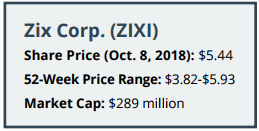 That problem is only going to get more prevalent as businesses embrace “bring your own device” (also called BYOD) policies, which allow employees to use their own personal devices to perform work-related functions.
That problem is only going to get more prevalent as businesses embrace “bring your own device” (also called BYOD) policies, which allow employees to use their own personal devices to perform work-related functions.
That’s a huge problem – but it also creates a huge opportunity.
The worldwide market for email encryption and threat protection has reached $3.0 billion, according to Gartner Research.
And that brings me to Penny Tech Stock No. 4: Zix Corp. (NasdaqGS: ZIXI).
Founded in 1983, and based in Dallas, the company provides solutions for email encryption, data loss prevention, threat protection, archiving, and BYOD mobile security.
The company has more than 19,000 customers – including all U.S. Federal Financial Institutions Examination Council (FFIEC) regulators, divisions of the U.S. Treasury, the U.S. Securities and Exchange Commission, 30% of U.S. banks, 30% of Blue Cross Blue Shield plans, and over 1,200 U.S. hospitals.
The company’s email encryption services encrypt and deliver more than 1.4 million emails every day – including service that allows users to use their own devices without ever having the emails stored locally on their own devices.
That’s a big deal because it protects business communications (and data) in the event someone loads an unintended malware on to their device after clicking on a cute cat video link in their personal email.
To keep customer emails safe, Zix encrypts, quarantines, archives, and filters all outgoing emails and runs threat protection software, content filtering, and archiving to all incoming emails.
And here’s what I really like about Zix…
There are other companies that exclusively provide solutions such as email encryption, email security, or security suites – but Zix offers all three.
Here’s why that’s important…
If you’ve ever tried to piece together security solutions from various vendors, you’ve probably already experienced the gigantic headache of trying to get three different protocols to play well together – not to mention the hassle of having to learn multiple rules and workflows.
Zix customers, on the other hand, don’t have to worry about any of that because all of the company’s products and solutions have been designed to share a common language and workflow.
From 2014 to 2017, the company reported revenue growth of 30.6%, from $50.3 million in 2015 to $65.7 million in 2017.
And for 2018, expect revenue to reach between $69 million to $70.5 million. Meeting those numbers shouldn’t pose any problem considering the company’s backlog is $70.8 million, as of March 31, 2018.
Additionally, the company’s balance sheet looks good. As of the end of Q1/2018, it reported $29.3 million in cash versus no liability. That gives the company flexibility to make strategic acquisitions or to merely increase shareholder value through a stock buyback program – the latter of which it’s already doing.
Since 2011, the company has repurchased $86 million worth of stock, and, as of January 1, 2018, it authorized an additional $6 million buyback program.
Those numbers might not sound very big, but Zix is only a $289 million company, so they’re actually pretty significant.
LIVE ON CAMERA: Watch America’s #1 Trader Officially Become $1,050 RICHER in 15 SECONDS!
Penny Tech Stock No. 5
This Smartphone Play Has Triple-Digit Prospects
When I'm in search of tech stocks with the potential to double your money, there may be no better "test" than to see how they perform during a correction.
It's a profit-seeking method that truly pays off.
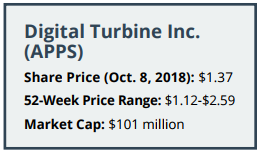 Just take a look at how Digital Turbine Inc. (NasdaqCM: APPS) behaved during a recent market correction.
Just take a look at how Digital Turbine Inc. (NasdaqCM: APPS) behaved during a recent market correction.
Between Jan. 26, 2018, and the bottom on Feb. 8, the S&P 500 fell roughly 10%.
But during that same period, shares of Digital Turbine powered right through. Yes, it had some weak days, but it gained more than 16% while most of the rest of the market was getting slaughtered.
That's a sign of a powerful stock that investors are clamoring to own. And please don't worry: I still see plenty of upside.
Here’s why…
Digital Turbine is a key provider of technology that most Americans can't live without these days – smartphone apps.
Consider when you buy a new smartphone. You'll see that it already comes preloaded with a handful of apps when you take it out of the box. In most cases, your wireless provider has turned to Digital Turbine to get those apps there.
The Austin-based firm has cornered this market. And 71% sales growth in its most recent quarter shows that a rising number of phone service providers are seeking out this firm's expertise.
But Digital Turbine has just scratched the surface of its potential market. Its Ignite software is now installed on 130 million smartphones and devices.
According to data from the market researchers at Statista, there are 2.32 billion smartphones in the hands of consumers worldwide right now. And that figure is set to rise 24% to 2.87 billion by 2020.
That’s Digital Turbine’s full potential market.
Digital Turbine provides all the tools a phone service provider needs, with a suite of customizable templates that play up the phone's most advanced features and services.
This firm doesn't play favorites. It's working with more than 30 of the world's top mobile operators and can support more than 200 unique devices.
We're talking about blue-chip clients like Verizon Communications Inc. (NYSE: VZ), T-Mobile US Inc. (NasdaqGS: TMUS), Vodafone Group plc (NasdaqGS: VOD), AT&T Inc. (NYSE: T), and Deutsche Telekom AG (OTC ADR: DTEGY).
Digital Turbine's rapid growth just helped it reach a key milestone. Earlier this year, the firm delivered its first-ever quarterly profit, meaning it has no need to sell more shares to fuel growth as many young firms do.
And the stage is set for much deeper ties with its client base. Digital Turbine is now building out many more tools and features, such as "Single-Tap" and "Smart Folders."
In late January, Digital Turbine placed itself in front of many more potential clients by signing a multiyear deal with Qualcomm Inc. (NasdaqGS: QCOM) to extend many features of the Insight software to clients across Asia.
That's a market that Qualcomm has said it will aggressively target in 2018.
While 71% sales growth in a recent quarter was impressive enough, it's clear that Digital Turbine has plans to keep growing at a very rapid clip.
Add it all up and you can see why I believe you have a good shot at doubling – or better – your money with this play.
3 Rules for Penny Tech Stock Investing
You now know trading penny tech stocks can be extremely lucrative – and also extremely risky.
What you might not know is that you can limit the risk by following three important rules.
You see, most traders buy microcaps such as these without knowing if the company they invested in has real profit potential.
Not only is this unwise – but it can cost you your entire investment.
To help you identify the most profitable penny tech stocks to own, I’m showing you the three rules that will help you pick microcaps with real profit potential.
- Stick to Penny Tech Stocks With Great Growth Potential – We've all heard that penny stocks can generate triple-digit gains for shareholders in a matter of days.
Sure, they can. But very few actually do.
The fact is that most penny stocks lack the strong financials necessary for the kinds of returns we’re looking for.
Take VistaGen Therapeutics Inc. (NasdaqCM: VTGN) as an example.
Last December, this biotechnology company won discretionary approval from the U.S. Food and Drug Administration for an anti-depression drug it was developing.
Eager investors, believing that a profit was inevitable, bought into VistaGen’s stock, pushing its price from $0.92 to $2.55 – a staggering gain of 177%.
However, VistaGen's temporary breakthrough was not enough to sustain this kind of growth. Over the next two weeks, the stock pulled back to $1.08, leaving investors who bought at $2.55 with an almost 60% loss.
VistaGen is a great example of what happens with most penny stocks, even the stocks that soar. Lacking real growth potential, they end up burning investors who piled on without a second thought.
That’s why it’s important to stick to penny stocks with the kind of financial health that can generate the great returns we’re looking for. Make sure the underlying businesses are healthy, profitable, have the ability to compete in their market space, and whose executives are invested in the company.
It’s also the reason you need to follow this next rule…
You Could Be Paid $2,353: Very soon, we'll be releasing a very simple set of instructions to a selection of our readers. Each person who follows these steps could be paid a total of $2,353 in only 28 seconds. You won't need to buy a single share of stock up front to collect this cash. Click here to find out how…
- Steer Clear of “Quick Returns” Promises – Investors who are new to penny tech stocks often believe these little-known companies are “guaranteed” to provide triple-digit returns simply because they’re listed on an exchange.
This just isn't the case.
While some investors get lucky and identify a penny stock right before it jumps on a sudden development, most penny stocks stay flat or fall and become worthless.
As a result, you could be left with an empty wallet and no returns to show for it anytime soon.
So don’t bank on striking it lucky with penny stocks, and avoid promoters and scam artists promising overnight gains if you buy the stock they’re hawking.
In fact, most penny stock investors end up doing this repeatedly due to one common misconception…
- Avoid Risky Penny Tech Stocks – When researching the best microcaps, you'll often hear that penny tech stocks only have profit potential because they’re so risky.
While risk plays a role in determining a stock’s profitability, the truth for penny stocks is a little more complex.
You see, the less risky a penny stock is, the greater chance it has of providing shareholder with the kind of gains that define a worthwhile investment.
That’s because a penny tech stock with strong underlying financials and plenty of opportunity for growth is, by default, not a risky investment.
In fact, these are the kind of investments smart investors look for every day, no matter how much they cost.
I hope you find more of them.
Cheers and good investing,

Michael A. Robinson


